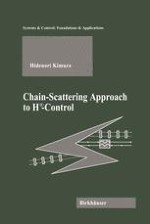
1997 | OriginalPaper | Chapter
Introduction
Author : Hidenori Kimura
Published in: Chain-Scattering Approach to H∞ Control
Publisher: Birkhäuser Boston
Included in: Professional Book Archive
Activate our intelligent search to find suitable subject content or patents.
Select sections of text to find matching patents with Artificial Intelligence. powered by
Select sections of text to find additional relevant content using AI-assisted search. powered by
Before 1960, control theory was composed of several classical theorems such as the Routh-Hurwitz stability criterion, Nyquist stability theorem, Bode’s dispersion relations, Wiener’s realizability criterion and factorization theory on the one hand, and a set of design algorithms such as lead-lag compensation, Smith’s prediction method, Ziegler-Nichols ultimate sensitivity method, Evans’ root locus method, and the like on the other hand. Although the preceding theoretical results were highly respected, they were not closely related to each other enough to form a systematic theory of control. However, classical design algorithms such as lead-lag compensation were not clearly formalized as a design problem to be solved, but rather as a tool of practices largely dependent on the cut-and-try process. They were usually explained through a set of examples.